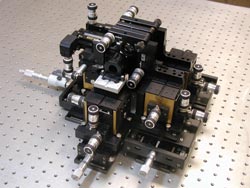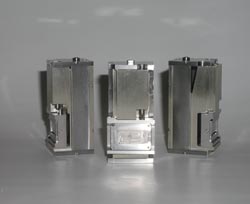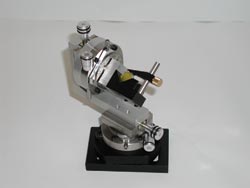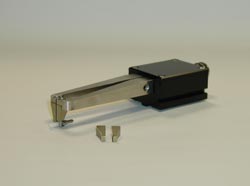Colin Freeland, Elliot Scientific Ltd.
In nearly all optical experiments, there must be some degree of adjustment. Depending on the optical elements involved, the experiments may require up to six degrees of freedom. A mirror mount in an interferometer might need only two rotational axes, but it may require arc-second angular resolution. Aligning single-mode optical fibres to double-sided planar waveguide structures often requires all six axes of adjustment with submicron resolution.
In many cases, standard stages provide the necessary micropositioning control in the laboratory, so using these devices is often a simple and cost-effective way to proceed. Many types of micropositioners, ranging in size from a few centimetres to more than a metre, are available. Elliot Scientific Ltd. of Harpenden, UK, specializes in small positioners with up to 10 mm of travel but with accuracies down to less than 50 nm.

This complex multiaxis positioning system incorporates five precision X-Y-Z flexure stages combining spatial flexibility with extremely high precision.
Multiple stages can be combined to achieve multiaxis positioning. For example, a system incorporating five precision X-Y-Z flexure stages can address the needs of launching light into planar waveguide structures. This application requires both extremely high precision and multiaxis positioning.
By combining a three-axis linear dovetail slide, a rotation stage and a two-axis tip/tilt stage, Elliot can achieve six axes of adjustment from an assembly of standard components. The lapped dovetail slides and bearings produce a smooth movement, while the 0.25-mm-pitch adjusters yield high resolution. Moreover, the locks on the tip/tilt stage provide a high degree of stability.

Elliot Scientific Ltd. packed a linear axis and two rotation axes into a fully custom unit with a height of 55 mm.
Custom solutions
If off-the-shelf components don’t exactly meet the positioning requirements, it is still usually possible to find a solution. By adding custom interfaces and adaptors to locate the rotation points on the surface of the optic, we can produce a miniature manipulator from standard components that gives two rotation and two linear axes. Where there are space constraints, however, standard stages are not always easily available to fit. In these situations, we have to modify the stages with special mounting arrangements and adjusters.

Custom interfaces and adaptors enable this miniature manipulator to provide two rotations and two linear axes from otherwise standard components.
A challenging, but common, situation is one in which not only is space limited but also systems must fit within a particular shape or cavity. Elliot designed a special stage to fit within a 50-mm-diameter circular vacuum chamber. It has a custom adaptor block and specially shortened adjusters. Sometimes there is enough room for the stage but not for the adjuster necessary to move it. We may need to use a stage that is already small and modify or cut down the adjusters so the whole thing fits into the space and the travel range is maintained.
Eventually, when the task cannot be performed by modifying standard stages, the solution is to build fully custom units. As part of an x-ray monochromator, we designed and built a unit with two rotations and one linear axis, all adjustable from above, in a volume no larger than 20 × 21 × 55 mm.
It is not just space restrictions that necessitate custom designs. Positioning stages must sometimes meet the needs of challenging environments. The need for adjustment in high magnetic fields has led to the design of special nonmagnetic stages. Depending on the strength of the magnetic field, various degrees of nonmagnetism are required. In the most extreme cases, where even stainless steel is out of bounds, the stages have to be modified with specially wound springs and machined screws made from nonmagnetic materials such as beryllium copper.
Applications in vacuum require special materials and lubricants. This is particularly the case in laser cavities where outgassing from standard stages can cause contamination problems.

The MDE770 fibre gripper is a standard product in the Elliot range that emerged from work on a challenging customer application.
Spin-off products
Many of the products in the Elliot range have been developed as a result of customers requesting particular solutions. A good example is the MDE770 fibre gripper. Many of the applications we have been involved in require aligning fibres to laser diodes either for testing or assembly. The challenge was to hold the fibre or ferrule inside a butterfly laser diode package while aligning it to the output of the laser and continuing to hold it until attachment and release, without causing it to move.
Meet the author
Colin Freeland is photonics products manager at Elliot Scientific Ltd. in Harpenden, UK.